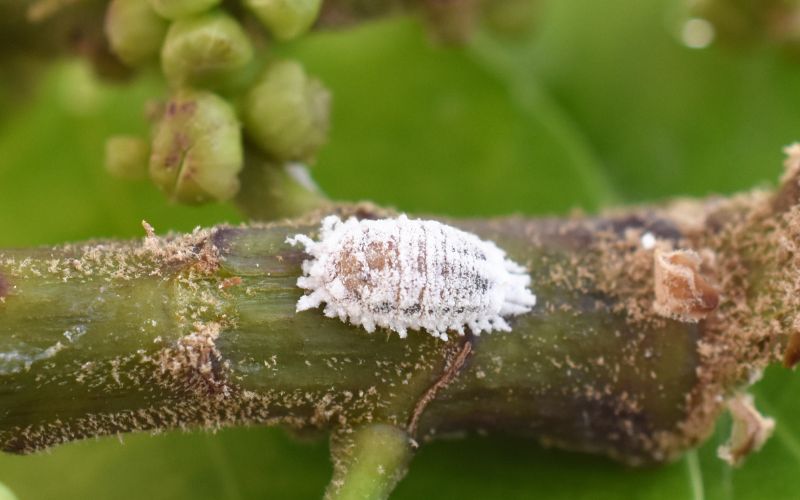Mealybugs are white cotton-looking bugs that are commonly found on vegetable plants. If you identify mealybugs early on before they cause an infestation, you can mechanically remove them to protect your plants from any further damage.
Although root mealybugs look very similar to mealybugs that feed on plant leaves and stems, they are a completely different type of insect and are not dealt with in this article.
Identifying mealybugs on your vegetable plants
Mealybugs are small oval-shaped insects that can cause significant damage to a range of plants, including all vegetable plants. Mealybugs are related to aphids, whiteflies, and scale insects, and cause similar damage to plants as they all suck out and feed on plant sap.
1. White cottony stuff on leaves and stems
Mealybugs are small, soft-bodied insects that are oval-shaped and usually cream to white in color. They have a powdery, waxy coating that gives them a cottony appearance from a distance, and also their name.

If you look closely, you can easily see the individual insects. Some species of mealybugs secrete this wax in a way that gives the impression of having a tail.

The adult females, which are around 1 cm in length, can move slowly using their thin and tiny legs. The immature stages look similar but are smaller. They initially move around but settle down once they start feeding on plant material. Adult male mealybugs do not feed on plants and resemble small flies, although they are rarely visible.

Female mealybugs lay their eggs under cottony waxy secretions found on leaves and stems, while some species keep their eggs beneath them until they hatch.
Mealybugs can move from one plant to another if the plants are very close together or if infected plant material comes into contact with other plants.
2. Yellow or brown distorted and curled leaves that give the plant a dry look
Mealybugs are usually found on the undersides of leaves on the veins. They suck the sap out of plants, leaving plant leaves with a lack of nutrients that causes leaves to become distorted and curled. The leaves eventually turn yellow and fall off. The plant will look dry even if it’s properly watered and cared for.

3. Honeydew (sticky sugary secretions) left on leaves
Sugars are the main component of plant sap, and the excess sugars consumed by mealybugs are excreted. Mealybug excretions, which are sticky and generally referred to as honeydew, are left on the leaves. As we’ll see later, honeydew can create other issues.
4. Ants around the white cottony stuff (mealybugs)
Ants ‘farm’ mealybugs to feed on the honeydew that is excreted by them. In turn, ants protect mealybugs from natural predators and remove harmful bacteria by cleaning mealybug colonies. As a result, ants may bring mealybugs into your garden or move them from plant to plant.

5. Leaves and stems that look like they have been speckled or coated with a thin black film
Black sooty mold is a type of fungus that can be seen on leaves and stems, giving it the appearance of being speckled or coated with a thin black coating. This type of fungus can be wiped off the leaf surfaces because it does not harm the plant directly, but it does reduce photosynthesis and so plant growth.
Controlling insects that produce honeydew can stop the fungus from spreading. If the plant affected isn’t infested with insects that produce honeydew, the honeydew may be falling from a plant above it.
Getting rid of mealybugs
Plants that have been affected by mealybugs can recover as long as you are able to get rid of the mealybugs as soon as possible. You should start as soon as you notice mealybugs on your plants but it could take weeks for you to completely get rid of them.
1. Physically remove mealybugs
Although adult female mealybugs are easily visible due to their larger size, they are masters at hiding on plants right before your eyes. They can hide inside curled leaves, under leaves, and stems, so be sure to move around and look at all parts of your plants to get rid of as many as possible.
Once you have identified mealybugs on your plants, your first course of action should be to physically remove the large females and immature mealybugs that are visible. You can use a damp tissue or alcohol to wipe off the mealybugs and their cottony waxy secretions, to get rid of as many immature mealybugs and eggs as possible. You will have to repeat this every other day, for a couple of weeks even, until you no longer can see any more mealybugs.
Mealybugs don’t bite humans or other animals. If it is your first time dealing with mealybugs you should take care because some people can have mild allergic reactions, such as a slight skin irritation after contact with their waxy secretions.
2. Properly dispose of infected plant material
If there are stems and leaves that have a large number of mealybugs on them and have already turned yellow or brown, the best option would be to prune away these stems and leaves. Take care not to let the pruned stems and leaves touch other parts of the plant or any other plants so you don’t accidentally spread mealybugs. You can dispose of the pruned mealybug-infected plant material by burning or adding it to a hot and active compost bin.
3. Use a homemade spray to remove all traces
After physically removing any visible signs of mealybugs you can use a homemade pest control spray, such as garlic or hot pepper spray, or dust on chili powder or diatomaceous earth. This will get rid of mealybugs and control ants that have been farming the mealybugs. You will usually have to repeat this every other day or so for a couple of weeks to see lasting results.
Protecting your plants from mealybugs
The best way to stop a mealybug infestation is to protect your plants from being exposed to mealybugs.
1. Check plants from a nursery for signs of mealybugs
Mealybugs can easily be carried into your garden on infected plants, so you should properly check any plants that you bring in. You can keep them a slight distance away from your other plants for a few days to check if they develop any signs of mealybugs, other pests, or diseases, before bringing them closer to existing plants.
2. Practice proper gardening cleanliness
You should also properly wash your shoes, gloves, and gardening tools, and if possible leave them to dry in the sun, after you or someone else has used them outside your garden or on mealybug-infected plants.
3. Check your plants regularly
Mealybug infestations usually occur when the temperature is warm but not necessarily very hot or dry. You should check your plants regularly, if possible every day, for signs of mealybugs, aphids, whiteflies, spider mites, and other common pests, during warm weather or if you are growing your plants in a greenhouse. Special attention should be paid to the underside of leaves and parts of the plant, where these pests hide.
4. Encourage beneficial insects and other beneficial creatures
You can also encourage insects and other animals that will eat mealybugs to keep their populations under control and prevent infestations. Ladybug beetles, lacewings, spiders, lizards, frogs, and toads, are all good at controlling mealybugs. The larval stage of mealybug destroyers, a type of ladybug beetle, is specialized in preying on mealybugs.

Not using harsh chemicals or pesticides, mulching, planting flowering plants that attract a range of insects, and other ways of creating a naturally balanced organic garden will help you encourage and attract these beneficial creatures into your garden.
Mealybugs are common pests found on vegetable plants, and it’s important to identify them early on to prevent infestations. To control mealybugs, it is recommended to physically remove them followed by using homemade sprays or natural remedies to completely eliminate them and the ants that protect them. Regularly monitoring your plants, practicing gardening cleanliness, and encouraging beneficial creatures to your garden can help prevent mealybug infestations.

